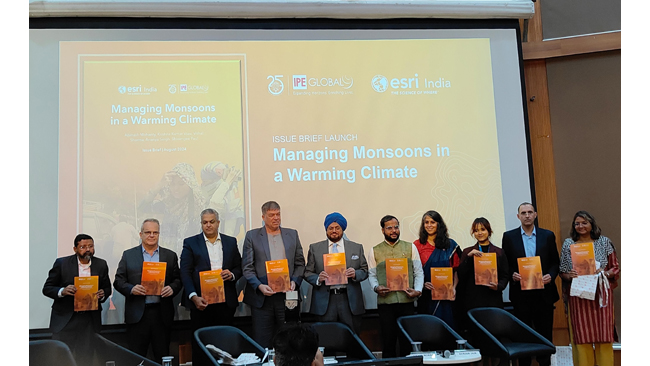
New Delhi, August 2024.
Over84percentofIndiandistrictsarepronetoextremeheatwaves,ofwhich
70 per cent of them are witnessing increased frequency and intensity of extreme
rainfallevents, according to a first-of-its-kind independent study released
today by the IPE-Global and Esri India. The frequency, intensity, and
unpredictability of these extreme heat and rainfall events
havealsoriseninrecentdecades.WhileIndiahaswitnesseda15foldincreaseinextremeheatwavedaysacross
the march-April-May (MAM) and June-July-August-September (JJAS) months in last
threedecades, last decade alone has witnessed a 19 fold increase in extreme
heat wave days. The
studyalsofoundthatmonsoonsseasonsinIndiaarewitnessinganextendedsummerlikeconditionexcepton
non-rainy days. The study was launched at a National Symposium titled “How can
India address climate extremes” organised by IPE Global, Esri India and its
partners UNESCO and Climate Trends today- as the world is gearing up for the
Climate Week NYC, USA where business leaders,
politicalchangemakersareexpectedtodeliberatetheonclimateactioncommitments.
Abinash
Mohanty, Head- Climate Change and Sustainability Practice at IPE Global and the
author ofthestudy,said,“Thecurrenttrendofcatastrophicextremeheatandrainfalleventsarearesultantof0.6
°C temperature rise in the last century. El Nino is gaining momentum and making
its earlypresencefeltacrosstheglobewithIndiafacingtheextremeeventsturbulencemoreinpatternsthanwaves.
Recent Kerala landslides triggered by incessant and erratic rainfall episodes
and the cities getting paralysed with sudden and abrupt downpour is a testament
that climate is changed.
Ouranalysissuggeststhat8outof10Indianswillbehighlyexposedtoextremeeventsby2036andthesenumbers
peak of volumes. Embracing hyper-granular risk assessments and establish
climate-riskobservatories should become a national imperative to safeguard
Indian agriculture, industry,
andlarge-scaleinfrastructuralprojectsfromthevagariesofclimatechange”.
Agendra Kumar,
Managing Director, Esri India, said, “The
increasing frequency and intensity of heatwaves in conjunction with intense
precipitations are causing significant impacts on lives, livelihoods, and
infrastructure. A holistic, data-driven approach is essential for informed
policy decisions, climate adaptation, and resilience. GIS technology, with
advanced spatial analysis tools and the ability to integrate a variety of data,
enables a comprehensive understanding of the impact of climate from economic,
social, and environmental perspectives. Decision-makers in government can use
it for resilient infrastructure planning & development, disaster management,
and citizen engagement. Businesses can integrate climate insights for better
strategic planning and building higher resilience in supply chains and business
operations. GIS technology is already the core foundation of various disaster
resilience programs, infrastructure, utilities, natural resources management,
and missions like smart cities, AMRUT, National Water Mission, and Clean Ganga,
among others. At Esri India, we continuously work towards enabling our partners
and end users with the latest technology, tools, and data, so that they can use
mapping and location analytics to manage the impacts of climate change in their
efforts to build a sustainable future for all.”
TheIPEGlobalstudyfoundthatmorethan84percentofIndian
districts can be considered extreme heatwave hotspots, of which around 70 per
cent havewitnessed incessant and erratic rainfall more recurrently (in last
three decades) in the last
threedecadesinthemonsoonseason(JJAS).Further,inOctober,November,andDecember(OND),morethan
62 per cent of heatwave-prone Indian districts have been witnessing erratic and
incessantrainfall. The increase in atmospheric temperatures and humidity
increases the likelihood ofheatwaves globally, especially in tropical regions.
Based on the study’regional analysis the followingstatesare witnessing extreme
heat waves.
|
Region |
Statehotspots |
|
Coasts |
Gujarat,TamilNadu,AndhraPradesh,Odisha,Maharashtra |
|
Plains |
UttarPradesh,Rajasthan,MadhyaPradesh,Chhattisgarh,Haryana,Maharashtra,Punjab,Telangana,Bihar,Delhi |
|
Hills |
Tripura,Mizoram,JammuandKashmir,Uttarakhand,Meghalaya,HimachalPradesh |
Thestudyfoundatrendthatextremeheatwavehotspotsarewitnessinganincreaseinfrequencyandintensity
of incessant and erratic rainfall events. Districts on coasts—both the eastern
coast and western coast—have been observing unpredictable rainfall events more recurrently.
Districts withhigher heatwave occurrences in June-July-August-September tend to
have higher occurrences ofincessant and erratic rainfall events as well. Rising
temperatures and humidity in the
atmosphereincreasethelikelihoodofheatwavesglobally,especiallyintropicalregions.Theincreasedfrequencyandintensityofheatwavedaysthataretriggeringincessantanderraticrainfalleventsduetoclimatechangeposesignificantchallenges,necessitatingcomprehensivestrategiesformitigationandadaptation
to protect affected vulnerable communities. The study finds that Around 8 out
of 10Indians are going to be exposed to extreme heat events by 2036. The study
also found that districtsthat identified district hotspots have undergone a 55
per cent change in land-use-land-cover. ThesechangingpatternsareduetomicroclimaticchangesacrosstheIndiansubcontinentthataretriggeredbylocalclimatechangedriverssuchasland-use-surfacechange,deforestation,encroachmentsuponmangroves,andwetlands.
The
study recommends that risk assessment principles should form the core of
India’s strategy tobuild heat wave and extreme rainfall resilience. As a first
step, it proposes establishing a heat riskobservatory (HRO)- an observatory can
help in identifying, assessing, and projecting chronic andacute heat risks at a
hyper-granular level to better prepare against heat-related extremities such
asurban heat islands, water stress, vector-borne diseases, crop loss, and
biodiversity and
ecosystemcollapse.ItalsosuggestsDevisingriskfinancinginstrumentstomitigateheatriskandextremerainfallevents.Further,itsuggestsappointingheat-risk-championswithindistrictdisastermanagement
committees-
this will allow these agencies to prioritise and unify the heat-risk mitigation
efforts atthedistrict leveland,consequently, accelerateheat resilience.
The
IPE and Esri study holds significance as it provides a micro-level hazard
assessment of heat
andrainfallextremesacrossIndiandistricts.Itarguesthatcomprehensiveriskassessmentsatthe
hyper-local level are the need of the hour and relying just on global models
wont be effective. Moreover,identifying and estimating climatic risks is one of
the global call-to-action to climate-proof lives,livelihoods, infrastructure
and economies at the India lead G20 presidency which is being
furthermaterialisedat thecurrenteditionofBrazilG20.